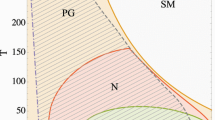Abstract
The basal area (Cu–Cu grid) of the cuprate superconductors not only tends to shrink on hole doping, as expected from single-electron quantum chemistry, but exhibits also an electronically incompressible “hump” around optimum doping n opt ≃ 0.16. The hump collapses near critical doping n crit≃0.19. We analyze the origin of the hump in terms of a classical liquid of interacting incompressible particles in a container with antiferromagnetic walls. Oxygen holes interacting with the wall form singlets, protect themselves against other holes by an incompressible “spin fence,” and thus interact also with the lattice. Occupation of the CuO2 lattice with holes must therefore follow a non-double-occupant constraint also for the oxygen cage enclosing the copper hole. Closest packing of self-protecting singlets is found to occur around critical doping; closest packing of paired self-protecting singlets around optimum doping. These singlet states are bosonic, but are not magnetic polarons.
Similar content being viewed by others
REFERENCES
E. Kaldis, in Handbook on the Physics and Chemistry of Rare Earths, K. A. Gschneidner Jr., L. Eyring, and M. Maple, eds. (North-Holland, Amsterdam, 2001), Vol. 31.
P. G. Radaelli, D. G. H. A. W. Mitchell, B. A. Hunter, J. L. Wagner, B. Dabrowski, K. G. Vandervoort, H. K. Viswanathan, and J. D. Joergensen, Phys. Rev. B 49 4163 (1994).
A. Fukuoka, A. Tokiwa-Yamamoto, M. Itoh, R. Usami, S. Adachi, and K. Tanabe, Phys. Rev. B 55 6612 (1997).
G. Böttger, I. Mangelschots, E. Kaldis, P. Fischer, C. Krüger, and F. Fauth, J. Phys. Condens. Matter 8 8889 (1996).
Q. Huang, J. W. Lynn, Q. Xiong, and C. W. Chu, Phys. Rev. B 52 462 (1995).
J. D. Joergensen, O. Chmaissem, J. L. Wagner, W. R. Jensen, B. Dabrowski, D. G. Hinks, and J. F. Mitchell, Physica C 282–287 97 (1997).
E. Kaldis, J. Röhler, E. Liarokapis, N. Poulakis, K. Conder, and P. Loeffen, Phys. Rev. Lett. 79 4894 (1997), cond-mat/9707196.
J. Röhler, in Concepts in Electron Correlation, V. Zlatic and A. Hewson, eds., (Kluwer, Dordrecht, The Netherlands, 2003), NATO Science Series, II, Vol 110,55. cond-mat/0210560.
T. Böttger and K. Dichtel (2003), private communication.
J. E. Hirsch, Phys. Rev. Lett. 59 228 (1987).
F. C. Zhang and T. M. Rice, Phys. Rev. B 37 3759 (1988).
J. R. Schrieffer, X.-G. Weng, and S.-C. Zhang, Phys. Rev. Lett. 60 944 (1988).
P. W. Anderson, The Theory of Superconductivity in the High-T c Cuprates, Princeton Series in Physics (Princeton University Press, Princeton, NJ, 1997).
K. A. Müller (2003), this conference.
R. J. McQueeney, Y. Petrov, T. Egami, M. Yethiraj, G. Shirane, and Y. Endoh, Phys. Rev. Lett. 82 628 (1999).
T. Timusk (2003), this conference.
Author information
Authors and Affiliations
Rights and permissions
About this article
Cite this article
Röhler, J. On Self-Protecting Singlets in Cuprate Superconductors. Journal of Superconductivity 17, 159–165 (2004). https://doi.org/10.1023/B:JOSC.0000011860.19159.2d
Issue Date:
DOI: https://doi.org/10.1023/B:JOSC.0000011860.19159.2d




